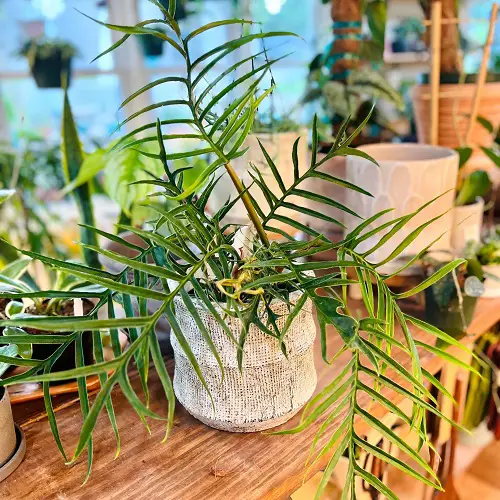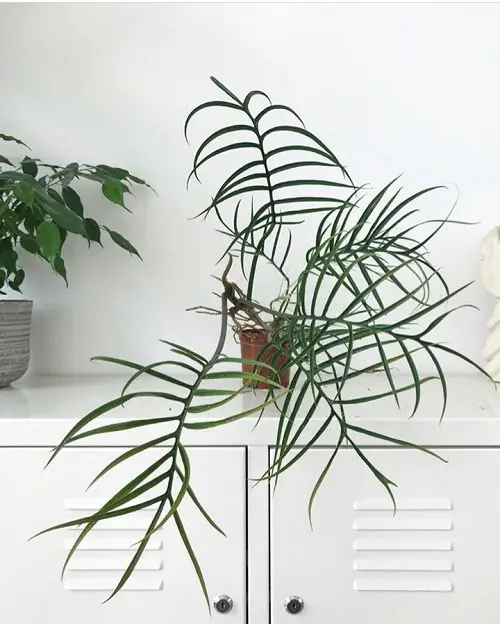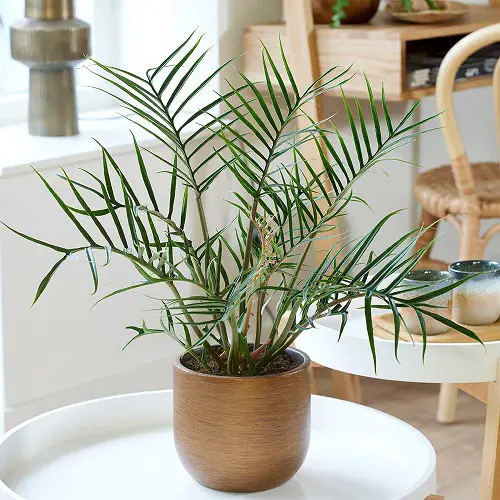We’ve got the best Philodendron Tortum Care and Growing Guide on the Internet that will help you grow it with ease!
Interestingly, the Philodendron tortum was only identified and classified as a distinct species in the last 20 years and is a relatively new addition to the Philodendron family.
USDA Zones: 10-11
Common Name: Fernleaf Philodendron
Philodendron Tortum Information
Philodendron tortum is an exceptional beauty with long, needle-like leaves. These lacy leaves make it different than other heart-shaped philodendrons and give it the appearance of a fern. This philodendron has a deep green color and has a natural ability to adapt, making it resilient.
Philo tortum is an epiphytic climber and grows on tree trunks in the wild with its aerial roots that help it anchor to other plants. In your home, it won’t climb walls on its own but you can give it a moss pole. They can easily reach 3-5 feet in height and will grow for many years because they’re not fussy and tolerate a lot of conditions.
Note: People often think that it undergoes a leaf transformation and its leaves turn from broad to thin and lacy once it matures, which is wrong. That’s because young Philodendron tortums actually look a lot like Philodendron elegans, which have a bit broader leaves.
Propagating Philodendron Tortum
You can easily propagate Philodron tortum with stem cuttings and via air layering. But we recommend going with stem cuttings because you can easily get one at your local nursery, and because air layering will make propagation a bit difficult as you’ll need sphagnum moss and plastic wrap.
Once you have the stem, cut it just below the node and let it callous for a day or two so there’s no rot. Now you can plant it in soil or a glass of water. If you pick water, make sure you keep things fresh and change it every 5-7 days. And for soil, go with misting instead of watering so it’s moist but not soggy. Once the roots are a couple of inches long, you can transplant them into a container.
You should propagate Philodendron tortum in late spring or early summer because that’s the active growth phase for these.
Choosing a Container for Philodendron Tortum
When selecting a container for your Philodendron tortum indoors, choose one that’s at least 8-12 inches deep and wide so there’s space for the roots. This pot will easily last your plant for a couple of years.
Requirements for Growing Philodendron Tortum
Sunlight
Philodendron tortum is just like other Philodendrons. It needs medium to bright, indirect light so an east or west-facing window or balcony is best for these. But do keep them out of direct sunlight. It will scorch the delicate leaves.
Soil
For a thriving tortum Philodendron, go for something well-draining. Take any good quality potting mix (2 parts) and add the following.
- A part of coco coir or perlite to help with the air porosity.
- A part of orchid bark or horticultural charcoal lowers the pH and increases drainage.
Water
It’s difficult to water your Philodendron properly so give it a deep soak until water runs out of the drainage holes and then let it rest. Water it again only when the top inch of the soil feels dry. Don’t use cold water as it will stress the plant.
Here are Cool Things You Can Do With Philodendrons in Home
Philodendron Tortum Care

Fertilizer
You can boost your plant’s growth by giving it a fertilizer specifically formulated for houseplants. But only do it in spring and summer and not in winter.
A ratio of 20-20-20 is great! You can also go for Miracle-Gro water-soluble fertilizers that are easy to apply and readily available.
Pruning
Pruning will help control the Philodendron tortum’s size and also encourage bushiness so you should do it in spring and summer when the plant’s growing. Cut anywhere on the healthy, overgrown stems but do it above the nodes. Don’t prune it excessively.
And if you’re growing it with a moss pole or a trellis, you’ll notice you don’t have to prune it that often.
Pests and Diseases
These Philodendrons might be infested with spider mites, aphids, and mealybugs so keep an eye out for these and use neem oil to get rid of them.
They’re generally hardy but sometimes suffer from fungal diseases like leaf spot and root rot if overwatered or exposed to excessive moisture. So err on the side of watering.





